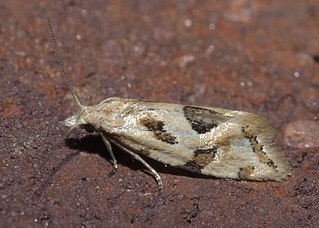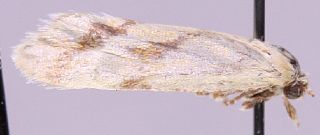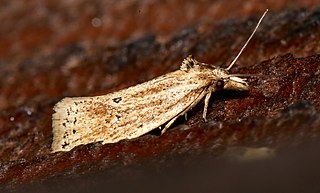
The Cochylini are a tribe of tortrix moths. It used to be classified as the subfamily Cochylinae.

Aethes is a genus of moths belonging to the subfamily Tortricinae of the family Tortricidae.

Aethes smeathmanniana, or Smeathmann's aethes moth, is a moth of the family Tortricidae. It was described by Johan Christian Fabricius in 1781. It is found in most of Europe, Asia Minor and in North America, where it has been recorded from New Jersey and Newfoundland and Labrador.

Crocidosema lantana, the lantana flower-cluster moth or lantana tortricid moth, is a moth of the family Tortricidae. It was first described by August Busck in 1910. It is native to Mexico and the southern United States, but was introduced to Hawaii in 1902, Australia in 1914 and the Caroline Islands in 1948 and 1949 to aid in the control of Lantana weeds. It has also been recorded from Yunnan, China and in Sri Lanka.

Aethes tesserana is a moth of the family Tortricidae. It is found in most of Europe, the Near East and northern Iran.

Aethes fennicana is a species of moth of the family Tortricidae. It is found in northern and central Europe, Iran and China (Xinjiang).

Aethes atomosana, the two-spotted aethes, is a species of moth of the family Tortricidae. It is found in North America, where it has been recorded from Nova Scotia, Ontario, Illinois, Indiana, Maryland, Michigan, Pennsylvania, Vermont and Wisconsin.
Aethes louisiana is a species of moth of the family Tortricidae. It is found in the United States, where it has been recorded from Missouri, Illinois and Indiana.

Aethes razowskii, Razowski's aethes moth, is a species of moth of the family Tortricidae. It is found in North America, where it has been recorded from Nova Scotia, Quebec, Alabama, Connecticut, Idaho, Indiana, Maine, Maryland, Michigan, New Hampshire and Vermont.
Aethes interruptofasciata is a species of moth of the family Tortricidae. It is found in North America, where it has been recorded from Manitoba, Nova Scotia, Illinois, Maine, Michigan, Missouri, New Jersey, Pennsylvania, West Virginia and Wisconsin. The habitat consists of deciduous forest openings and blueberry thickets.

Aethes biscana, the reddish aethes, is a species of moth of the family Tortricidae. It is found in North America, where it has been recorded from Connecticut, Florida, Illinois, Indiana, Kentucky, Maine, Maryland, Massachusetts, New Brunswick, New Jersey, New York, Ohio, Ontario, Pennsylvania, Quebec, South Carolina and Vermont.
Aethes bomonana is a species of moth of the family Tortricidae. It is found in the United States, where it has been recorded from Florida, Indiana, Louisiana and Ohio.
Aethes vachelliana is a species of moth of the family Tortricidae. It is found in the United States, where it has been recorded from California.

Phalonidia lavana, or Platphalonidia lavana, is a species of moth of the family Tortricidae, the subfamily Tortricinae, and the tribe Cochylini. It has a terrestrial habitat and is found throughout North America. It does not have a Global Conservation Status Rank.
Apachea barberella is a moth in the family Depressariidae, and the only species in the genus Apachea. It was described by August Busck in 1902. It is found in North America, where it has been recorded from Montana, Colorado, New Mexico, Arizona, Utah and California.
Agonopterix latipalpella is a moth in the family Depressariidae. It was described by William Barnes and August Busck in 1920. It is found in North America, where it has been recorded from Texas.
Agonopterix pteleae is a moth in the family Depressariidae. It was described by William Barnes and August Busck in 1920. It is found in North America, where it has been recorded from Illinois, Michigan and Ohio.

Eucosma abstemia is a species of moth of the family Tortricidae first described by Edward Meyrick in 1932. It is found in the United States, where it has been recorded from Colorado, Arizona and California.
Dichomeris simpliciella is a moth in the family Gelechiidae. It was described by August Busck in 1904. It is found in North America, where it has been recorded from southern Alberta to Texas, eastern Washington, south-eastern Nevada and Arizona. It has also been recorded from northern Mexico.

Gnorimoschema triocellella is a moth in the family Gelechiidae. It was described by Vactor Tousey Chambers in 1877. It is found in North America, where it has been recorded from Alberta, Colorado, Wyoming, Maine and Kentucky.











